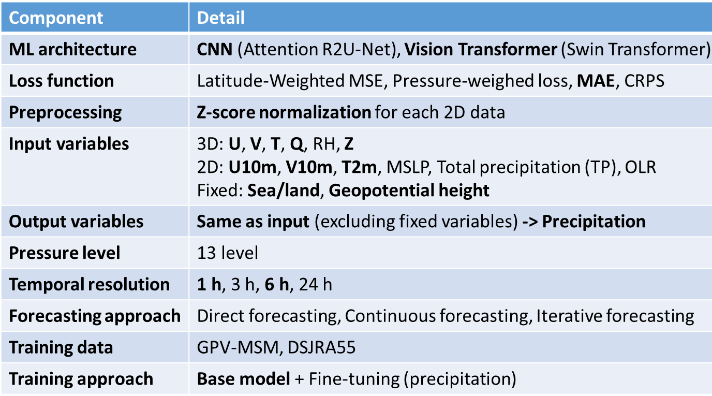Progress Report
Artificial generation of upstream maritime heavy rains to govern intense-rain-induced disasters over land (AMAGOI)[2] DNN for Weather
Progress until FY2024
1. Outline of the project
During 2024, we developed several prototypes of data-driven weather prediction model based on Vision Transformer and AR2U-Net architectures with reanalysis data around Japan. The model showed improvement in addressing the common issue of underestimating rainfall in several heavy rain cases. We also compared training methods and initialization strategies with existing models, gaining key insights into how these factors affect model performance and sensitivity to input perturbations.
2. Outcome so far
Based on the investigation of weather prediction models conducted in the previous fiscal year, we designed five prototype deep learning models specialized for weather forecasting around Japan. The architectures used were Swin-Unet, a type of Vision Transformer, and AR2U-Net, a type of CNN. All models were trained using 20 years of regional reanalysis data (RCDSJRA-55), with input variables including wind, temperature, humidity, and geopotential height at multiple pressure levels, as well as surface wind and precipitation. The models employed an autoregressive approach, predicting the next time step and using it as input for the following step.
The highest accuracy was achieved with the Swin-Unet–based model, which consisted of a Predictor that outputs future values and a Corrector that refines results using a diffusion model. The Corrector adds Gaussian noise to the predictions, then removes it through a diffusion process to restore high-frequency components, reducing excessive spatial smoothing. In the heavy rainfall event of October 25, 2019, the observed hourly maximum rainfall was 83.5 mm; the Predictor alone estimated 55.6 mm, while the combined use with the Corrector improved the estimate to 63.1 mm (Fig.1).

We also evaluated the impact of training methods and initialization settings on our improved ClimaX-based prediction model and compared it with publicly available data-driven models (Fig.2). The results revealed the limitations of autoregressive generation in improving prediction accuracy, as well as the significant influence of initialization settings.

3. Future plans
The models developed in 2024 are deterministic prediction models, meaning they produce a single forecast output based on a single initial condition. Moving forward, we plan to evolve them into probabilistic models capable of generating large- ensembles.
In addition, this year's comparison and evaluation of models allowed us to understand how differences in model initialization and input perturbations affect prediction results. We will incorporate these findings explicitly into the model and training process to improve both the accuracy and reliability of future forecasts.